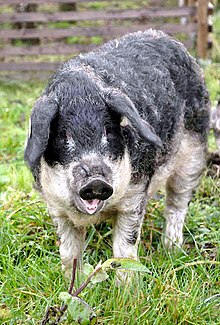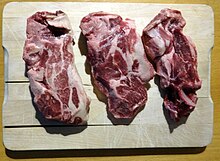Mangalica
 | |
| Other names |
|
|---|---|
| Country of origin | Hungary |
| Traits | |
| Weight |
|
| Hair |
|
| |
The Mangalica (also Mangalitsa or Mangalitza) is a
History
The blonde Mangalica variety was developed from older, hardy types of Hungarian pig (Bakonyi and Szalontai) crossed with the
The new, quick-growing, "fat-type" hog did not require any special care, which caused it to become very popular in Hungary. In 1927, the National Society of Fat-Type Hog Breeders (Mangalicatenyésztők Országos Egyesülete) was established, with the objective of improving the breed.[1] Mangalica was the most prominent swine breed in the region until 1950 (30,000 of them were in Hungary in 1943).[1] Since then, the popularity as well as the population of Mangalica has been decreasing, with the rising availability of food from farther away and refrigeration.[6] In 1991, there were fewer than 200 remaining Mangalica in Hungary. Monte Nevado, a Spanish company began the breeding and recovery of Mangalica, and they were awarded with the Middle Cross of Hungary in 2016.[7] Nowadays, the keeping of Mangalica has become a popular hobby.[1] Slightly over 7,000 Mangalica sows in Hungary are producing around 60,000 piglets a year.[8]
Apart from Hungary, the Mangalica is present in Austria, Canada,
The Romanian Native or
Husbandry


The Mangalica produces too little lean meat, so it has been gradually replaced by modern domestic breeds. It is usually fed with a mix of wild
The primary product made from this pig is
In Hungary, most Mangalica pigs are raised purely or semi-intensively.[citation needed]
Slaughter weight (for meat production) is generally achieved beyond 12 months of age.[23]
Meat from the Mangalica can be easily found in Hungary, as Hungarian farmers produce about 60,000 animals each year.[24]
Varieties
There are three existing varieties of Mangalitsa, differing only in colour: "blonde", "swallow-bellied", and "red". The "blonde" Mangalica is blonde, the "swallow-bellied" (originally produced by crossing the Blonde Mangalica with the extinct Black Mangalica)[1] has a blonde lower-portion of its body while the upper-portion of its body is black, and the "red" (produced by crossing the Blonde Mangalica with the Szalonta breed)[1] is ginger-coloured. Other varieties (including "black", "wolf", and "baris") have become extinct as pure-bred forms, though their reconstruction from selective breeding of mixed varieties is being debated in Hungary.[1]
References
- ^ a b c d e f g h i j Dr. Radnóczi László. "The Hungarian Mangalica". agroservice.hu. Archived from the original on 10 February 2012.
- ^ "🐖Breeding programme". www.moe.org.hu.
- ISBN 978-6155417047.
- ^ "Interessensgemeinschaft der Wollschweinzüchter Österreichs" (in German). home.tele2.at. Archived from the original on 7 April 2008.
- ^ J. Slatinac, "Zbog mangulice u Zasavicu", Politika (in Serbian)
- ^ "Salvan raza de cerdo magiar parecida al ibérico" [Magyar pig breed similar to the Iberian is saved]. La Prensa. Archived from the original on 12 March 2014.
- ^ "Hungría reconoce a Monte Nevado por su labor de recuperación de la raza Mangalica". www.qcom.es.
- ^ "Megjelent a mangalica Angliában: megmentett hobbiállat vagy régi magyar fajta". 31 January 1999. Retrieved 12 June 2013.
- ^ Campbell, Twyla (14 February 2017). "Mangalitsa: The hairy pig makes its Alberta debut". Eat North. Retrieved 16 October 2018.
- ^ "Maiale Mangulica - Arca del Gusto". Fondazione Slow Food (in Italian). Retrieved 10 October 2023.
- ISSN 0362-4331. Archived from the originalon 19 June 2014. Retrieved 10 October 2023.
- ^ "American Mangalitsa Association". American Mangalitsa Association. 23 July 2018.
- ^ Dragica Bajić (29 April 2008). "Mangulica, dabar i lokvanji". Politika Online (in Serbian). Politika. p. 41.
- ^ "Rare pigs are mistaken for sheep". BBC News. 19 April 2010.
- ^ Morris, Steven (26 May 2023). "Dorset 'super reserve' recreates ancient savannah habitat to boost biodiversity". BBC News. Retrieved 26 May 2023.
Instead of aurochs, considered the wild ancestor of domestic cattle, 200 red Devon cattle are to be found roaming the Purbeck Heaths, while Exmoor ponies are stand-ins for the tarpan horses and curly coated Mangalitsa pigs are doing the sort of rooting around that boars used to excel at here.
- ^ "An Old Breed of Hungarian Pig Is Back in Favor". The New York Times. 26 March 2009.
- ^ "Meet the Mangalitsa, the Hairy Pig That's the Kobe Beef of Pork". Modern Farmer. 14 March 2014.
- ^ "Is Mangalitsa the next 'it' pig?". The Seattle Times. 8 January 2011.
- ^ "Gentleman Pig Farmer". Barron's. 14 September 2013.
- ^ "Breeds of Livestock – Bazna Swine". 29 December 2010. Archived from the original on 29 December 2010. Retrieved 3 December 2022.
- ^ "The Slow Food Foundation for Biodiversity". fondazioneslowfood.it. Archived from the original on 3 August 2008.
- ^ "Breeds of Livestock – Switzerland". ansi.okstate.edu. 19 January 2021.
- ^ Sanders, Michael S. (1 April 2009). "An Old Breed of Hungarian Pig Is Back in Favor". The New York Times.
- ^ "Hungarian mangalica is introduced in the U.K" (in Hungarian). origo.hu. May 2010.
